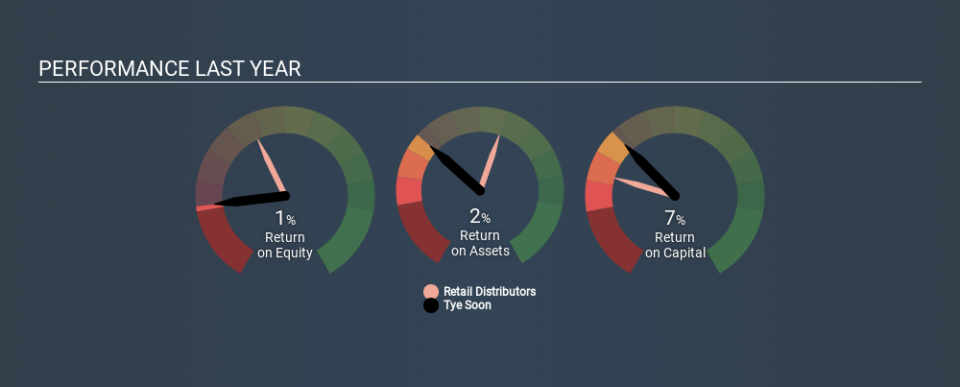Is Tye Soon Limited’s (SGX:BFU) 6.7% ROCE Any Good?

Today we'll evaluate Tye Soon Limited (SGX:BFU) to determine whether it could have potential as an investment idea. Specifically, we'll consider its Return On Capital Employed (ROCE), since that will give us an insight into how efficiently the business can generate profits from the capital it requires.
First, we'll go over how we calculate ROCE. Second, we'll look at its ROCE compared to similar companies. Last but not least, we'll look at what impact its current liabilities have on its ROCE.
Return On Capital Employed (ROCE): What is it?
ROCE measures the 'return' (pre-tax profit) a company generates from capital employed in its business. All else being equal, a better business will have a higher ROCE. In brief, it is a useful tool, but it is not without drawbacks. Author Edwin Whiting says to be careful when comparing the ROCE of different businesses, since 'No two businesses are exactly alike.
So, How Do We Calculate ROCE?
Analysts use this formula to calculate return on capital employed:
Return on Capital Employed = Earnings Before Interest and Tax (EBIT) ÷ (Total Assets - Current Liabilities)
Or for Tye Soon:
0.067 = S$3.8m ÷ (S$165m - S$108m) (Based on the trailing twelve months to December 2019.)
Therefore, Tye Soon has an ROCE of 6.7%.
View our latest analysis for Tye Soon
Does Tye Soon Have A Good ROCE?
When making comparisons between similar businesses, investors may find ROCE useful. Tye Soon's ROCE appears to be substantially greater than the 5.3% average in the Retail Distributors industry. We consider this a positive sign, because it suggests it uses capital more efficiently than similar companies. Setting aside the industry comparison for now, Tye Soon's ROCE is mediocre in absolute terms, considering the risk of investing in stocks versus the safety of a bank account. Readers may find more attractive investment prospects elsewhere.
Our data shows that Tye Soon currently has an ROCE of 6.7%, compared to its ROCE of 3.2% 3 years ago. This makes us wonder if the company is improving. You can click on the image below to see (in greater detail) how Tye Soon's past growth compares to other companies.
Remember that this metric is backwards looking - it shows what has happened in the past, and does not accurately predict the future. ROCE can be deceptive for cyclical businesses, as returns can look incredible in boom times, and terribly low in downturns. ROCE is, after all, simply a snap shot of a single year. If Tye Soon is cyclical, it could make sense to check out this free graph of past earnings, revenue and cash flow.
Tye Soon's Current Liabilities And Their Impact On Its ROCE
Short term (or current) liabilities, are things like supplier invoices, overdrafts, or tax bills that need to be paid within 12 months. Due to the way the ROCE equation works, having large bills due in the near term can make it look as though a company has less capital employed, and thus a higher ROCE than usual. To counteract this, we check if a company has high current liabilities, relative to its total assets.
Tye Soon has total assets of S$165m and current liabilities of S$108m. As a result, its current liabilities are equal to approximately 65% of its total assets. Tye Soon's current liabilities are fairly high, making its ROCE look better than otherwise.
What We Can Learn From Tye Soon's ROCE
Notably, it also has a mediocre ROCE, which to my mind is not an appealing combination. But note: make sure you look for a great company, not just the first idea you come across. So take a peek at this free list of interesting companies with strong recent earnings growth (and a P/E ratio below 20).
For those who like to find winning investments this free list of growing companies with recent insider purchasing, could be just the ticket.
If you spot an error that warrants correction, please contact the editor at editorial-team@simplywallst.com. This article by Simply Wall St is general in nature. It does not constitute a recommendation to buy or sell any stock, and does not take account of your objectives, or your financial situation. Simply Wall St has no position in the stocks mentioned.
We aim to bring you long-term focused research analysis driven by fundamental data. Note that our analysis may not factor in the latest price-sensitive company announcements or qualitative material. Thank you for reading.



